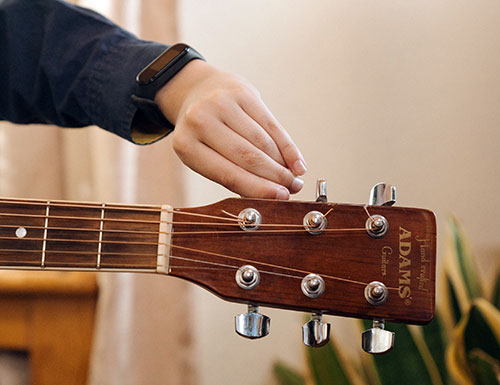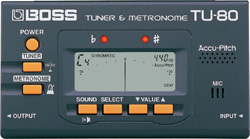Learn to tune a guitar (standard E-tuning @ 440hz)
Tuning a guitar is something every guitarist should be able to do – no excuse!
A guitar that is not properly tuned sounds out of tune, which does not promote the development of musical hearing. In addition, it is impossible to play together with other musicians if all instruments are not tuned correctly and / or not tuned according to the same tuning … Unless you want to scare away the neighbors, roommates or the public!

If it is a degree warmer in the rehearsal room than in your home, the guitar will have to be retuned.
A good tip when you are going to perform: put your guitar on stage an hour before the performance so that it can warm up. Often it is much warmer on stage (due to lighting etc) than in the guest room. Do not tune the guitar until it is air-conditioned. You understand what would happen if you entered the sweltering stage with a tuned “cold” guitar from the guest room … ? Within 60 seconds your guitar will sound as fake as a cat :-p! Not only the ambient temperature changes the tuning of the guitar, playing the guitar also detunes the guitar.
There is a certain tension on the strings, this tension causes the string to stretch slowly but surely. With certain playing techniques, the tension on the strings will be increased, such as bendings or the use of the whammy bar. Just play a Pink Floyd-like song, and you will notice that the typical David Gilmour technique, with bendings of sometimes 2 to 2.5 tones, can quickly detune your guitar.

The names of the strings on guitar (in standard E-tuning): from the thick string starting down : E (6), A (5), D (4), G (3), B (2) and E (1). Something that many guitarists and other musicians dare to forget: in our western music we tune our instruments according to the 440Hz tuning! In other countries, other types of music, or even with older pieces of music, tunings are still used that deviate from 435 to 445Hz. With a lot of guitar tuners this can be set and I notice more often with starters, when they complain that their guitar sounds false despite tuning, that sometimes the Hz button was accidentally pushed so that it is suddenly at e.g. 435Hz. So always check if your tuner shows 440Hz!
So far so good. Play the open E-string (thickest string / top string) and let it resound and certainly not strike continuously. Preferably also use your neck pickup, as it tunes better than the bridge pickup (this has to do with the wave movement of the strings). When the guitar tuner displays the letter E (or sometimes E6 of 6th string), the pitch is almost right. The hand or light on the guitar tuner indicates whether the pitch is too low (pointer to the left) or too high (pointer to the right).
Make sure that it actually says letter E and not, for example, Eb or D# (sometimes also D° for tuners that work with LED lights). So when you get D# or Eb, the string is tuned too low (too loose). When the guitar tuner displays the letter F, the string is stretched too hard (tuned too high). If the pitch is too low, the string must be tightened harder, if the pitch is too high, the string must be loosened.

Tips! Never turn the tuning keys too quickly, a minimal change can already make a big difference in terms of pitch. Moreover, it is important to always approach the pitch from below. That means, when the E string sounds just too high, turn the tuning key (string relaxed) until the tone drops just below the E. Then you tighten the string again, until the pitch rises to the perfect E. If you do not do this, your guitar may suddenly sound completely false during the next use. When the E string is tuned correctly, repeat the same steps with all other strings. Don’t forget to tune the guitar several times in a row, because due to the tension of the strings, the guitar neck bends slightly, so that the previous tuned strings are probably detuned again.
When all the strings are tuned, pull each string up a few inches and release it. Look at your guitar tuner again, and soon you will notice that the pitch for some strings has dropped again. Do not fear that a string will break when you pull it. If this does happen, it indicates either a worn string, only placed string, or a manufacturing defect … and rather the string breaks down while tuning than halfway through a song on stage! In the beginning, tuning a guitar is very frustrating and guaranteed to take you half an hour the first time. But no worry : practice makes perfect … After a while, tuning a guitar takes 10 seconds!

